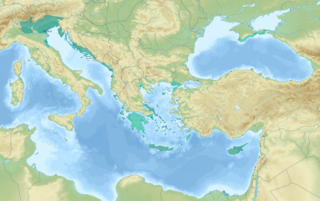 W
WThe Republic of Venice or Venetian Republic, traditionally known as La Serenissima, was a sovereign state and maritime republic in parts of present-day Italy which existed from 697 AD until 1797 AD. Centered on the lagoon communities of the prosperous city of Venice, it incorporated numerous overseas possessions in modern Croatia, Slovenia, Montenegro, Greece, Albania and Cyprus. The republic grew into a trading power during the Middle Ages and strengthened this position in the Renaissance. Citizens spoke the still-surviving Venetian language, although publishing in (Florentine) Italian became the norm during the Renaissance.
 W
WThe Albanian–Venetian War of 1447–48 was waged between Venetian and Ottoman forces against the Albanians under George Kastrioti Skanderbeg. The war was the result of a dispute between the Republic and the Dukagjini family over the possession of the Dagnum fortress. Skanderbeg, then ally of the Dukagjini family, moved against several Venetian held towns along the Albanian coastline, in order to pressure the Venetians into restoring Dagnum. In response, the Republic sent a local force to relieve the besieged fortress of Dagnum, and urged the Ottoman Empire to send an expeditionary force into Albania. At that time the Ottomans were already besieging the fortress of Svetigrad, stretching Skanderbeg's efforts thin.
 W
WAndrea Alessi was a Venetian Dalmatian architect and sculptor born in Durazzo, considered one of the most distinguished artists of Dalmatia.
 W
WFrang Bardhi was an Albanian Catholic bishop and writer. Bardhi is best known as an author of the early eras of Albanian literature. He served as Bishop of Sapë (1635–1644).
 W
WThe Dushmani or Dusmani were an Albanian family that ruled parts of Pilot, a historical province within the territory of the eponymous Dushmani tribe from the Dukagjin highlands in northern Albania, during 15th century rule under the Republic of Venice.
 W
WThe Duchy of Durazzo was a short-lived overseas colony of the Republic of Venice, encompassing the port city of Durazzo and its environs. It was established in 1205, following the dissolution of the Byzantine Empire in the aftermath of the Fourth Crusade, and lasted until it was reclaimed by the Byzantine Despotate of Epirus in 1213.
 W
WThe Dushmani or Dusmani were an Albanian family that ruled parts of Pilot, a historical province within the territory of the eponymous Dushmani tribe from the Dukagjin highlands in northern Albania, during 15th century rule under the Republic of Venice.
 W
WThe First Scutari War was an armed conflict in 1405–1412 between Zeta and the Venetian Republic over Scutari and other former possessions of Zeta captured by Venice.
 W
WPamalioti was a historical Albanian tribe and family that lived between Lake Skadar and the Adriatic Sea, in the region called Zabojane, and were vassals to the Serbian Despotate and then the Republic of Venice in Venetian Albania.
 W
WThe Second Scutari War was an armed conflict in 1419–1426 between Zeta (1419–1421) and then the Serbian Despotate (1421–1423) on the one side and the Venetian Republic on the other, over Scutari and other former possessions of Zeta captured by Venice.
 W
WThe Statutes of Scutari were the highest form of expression of self-government of Scutari (Shkodër) during Venetian rule. There were other cities in Albania which had statutes but only those of Scutari are preserved in their fullest form. They are composed of 279 chapters written in the Venetian language of 15th century. They were held in two copies, one in the treasury office of the city and the other on the city court office. Although similar to other Italian and Dalmatian cities statutes, they have been incorporated into many Albanian elements and institutions, such as Besa and Gjakmarrja.